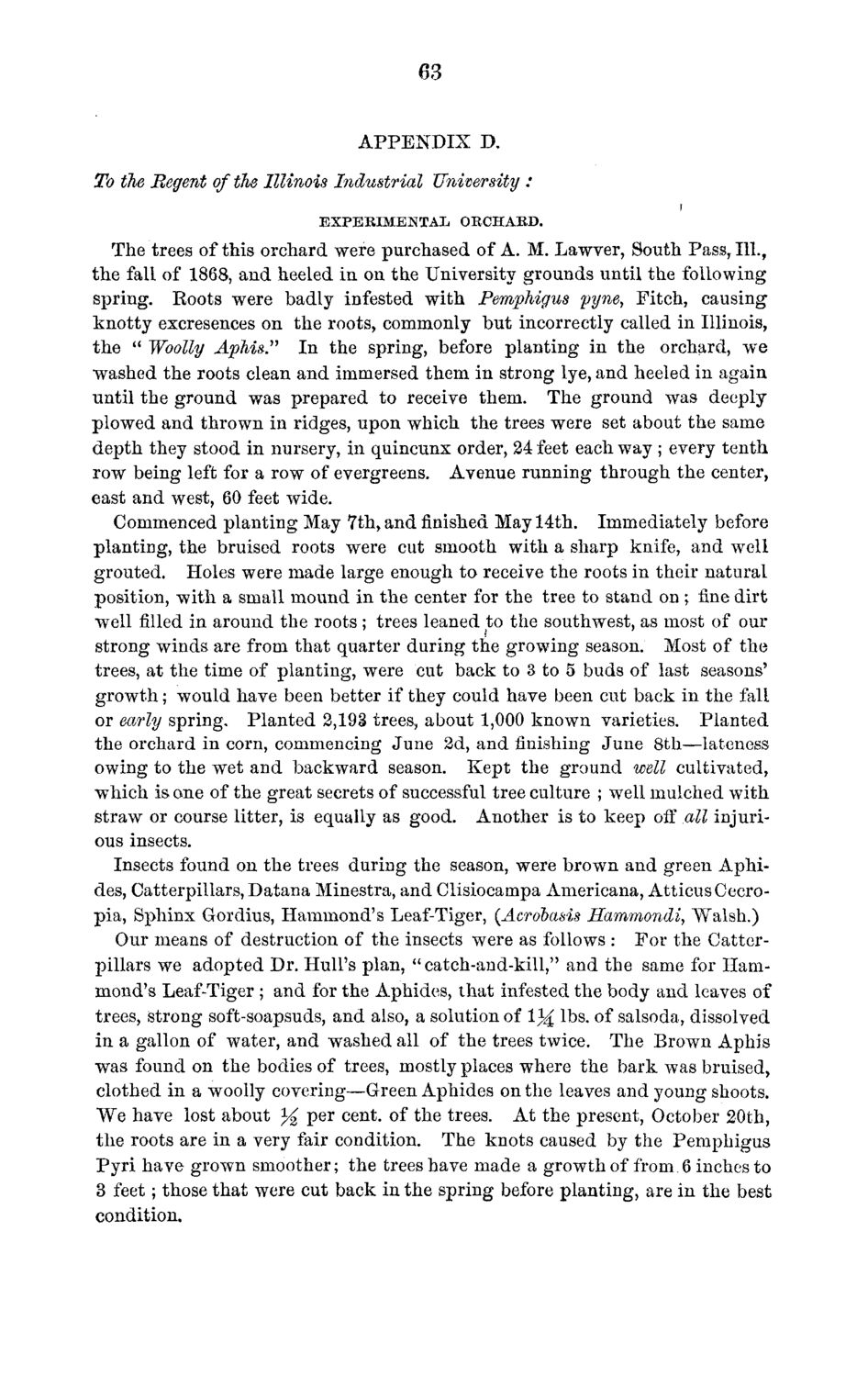| |
| |
Caption: Board of Trustees Minutes - 1870
This is a reduced-resolution page image for fast online browsing.

EXTRACTED TEXT FROM PAGE:
63 A P P E N D I X D. To the Regent of the Illinois Industrial University : i EXPERIMENTAL ORCHARD. The trees of this orchard were purchased of A. M. Lawver, South Pass, 111., the fall of 1868, and heeled in on the University grounds until the following spring. Boots were badly infested with Pemphigus pyne, Fitch, causing k n o t t y excresences on the roots, commonly but incorrectly called in Illinois, the " Woolly Aphis." I n the spring, before planting in the orchard, we washed the roots clean and immersed them in strong lye, and heeled in again until the ground was prepared to receive them. The ground was deeply plowed and thrown in ridges, upon which the trees were set about the same depth they stood in nursery, in quincunx order, 24 feet each way ; every tenth row being left for a row of evergreens. Avenue running through the center, east and west, 60 feet wide. Commenced planting May 7th, and finished May 14th. Immediately before planting, the bruised roots were cut smooth with a sharp knife, and well grouted. Holes were made large enough to receive the roots in their natural position, with a small mound in the center for the tree to stand o n ; fine dirt well filled in around the roots ; trees leaned to the southwest, as most of our strong winds are from that quarter during the growing season. Most of the trees, at the time of planting, were cut back to 3 to 5 buds of last seasons' g r o w t h ; would have been better if they could have been cut back in the fall or early spring. Planted 2,193 trees, about 1,000 known varieties. Planted the orchard in corn, commencing June 2d, and finishing June 8th—lateness owing to the wet and backward season. Kept the ground well cultivated, which is one of the great secrets of successful tree culture ; well mulched with straw or course litter, is equally as good. Another is to keep off all injurious insects. Insects found on the trees during the season, were browTn and green Aphides, Catterpillars, Datana Minestra, and Clisiocampa Americana, AtticusCecropia, Sphinx Gordius, Hammond's Leaf-Tiger, {Acrobasis Hammondi, Walsh.) Our means of destruction of the insects were as follows : F o r the Catterpillars we adopted Dr. Hull's plan, " catch-and-kill," and the same for Hammond's Leaf-Tiger ; and for the Aphides, that infested the body and leaves of trees, strong soft-soapsuds, and also, a solution of 1 ^ lbs. of salsoda, dissolved in a gallon of water, and washed all of the trees twice. The Brown Aphis was found on the bodies of trees, mostly places where the bark was bruised, clothed in a woolly covering—Green Aphides on the leaves and young shoots. We have lost about % per cent, of the trees. At the present, October 20th, the roots are in a very fair condition. The knots caused by the Pemphigus P y r i have grown smoother; the trees have made a growth of from.6 inches to 3 feet; those that were cut back in the spring before planting, are in the best condition.
| |